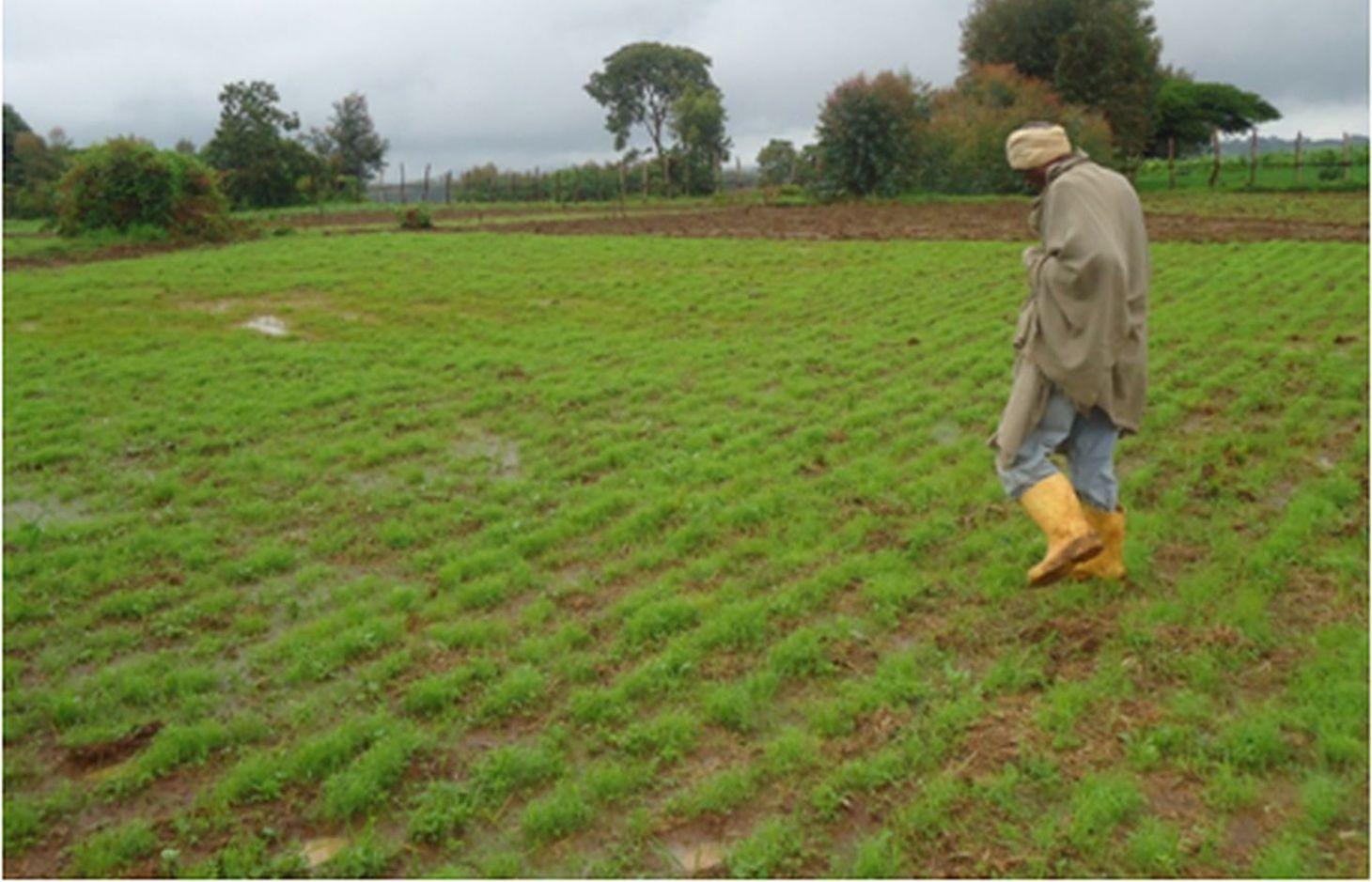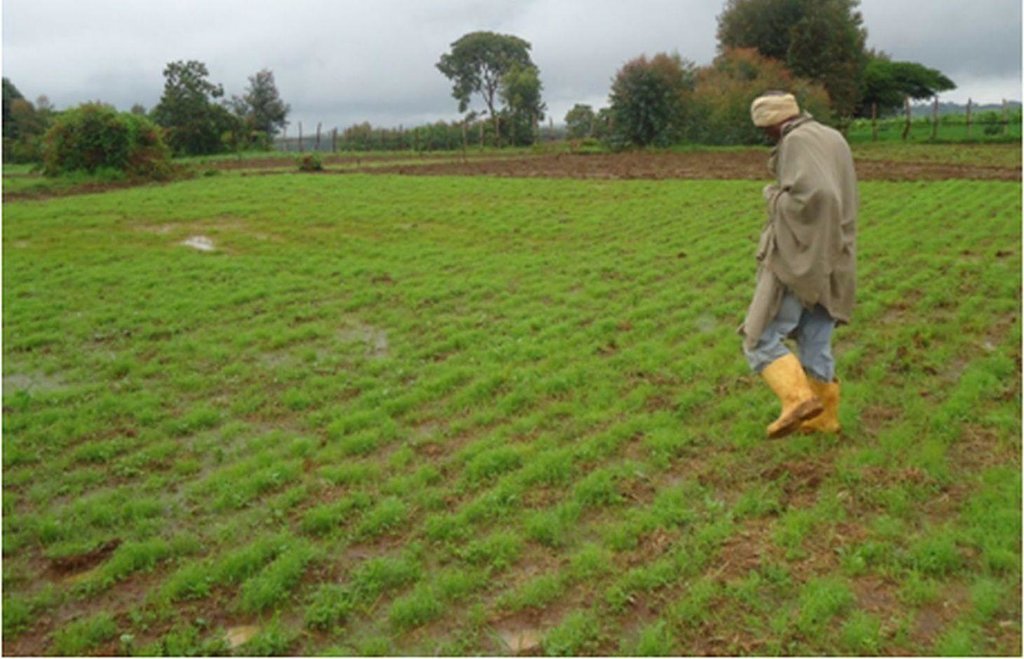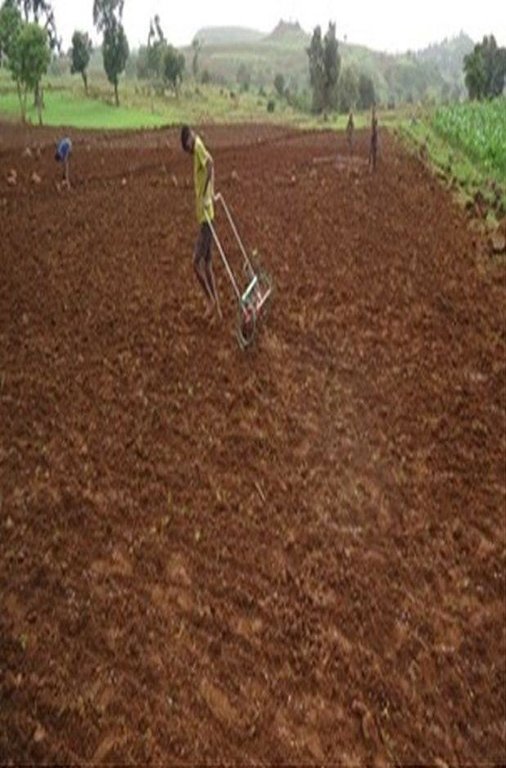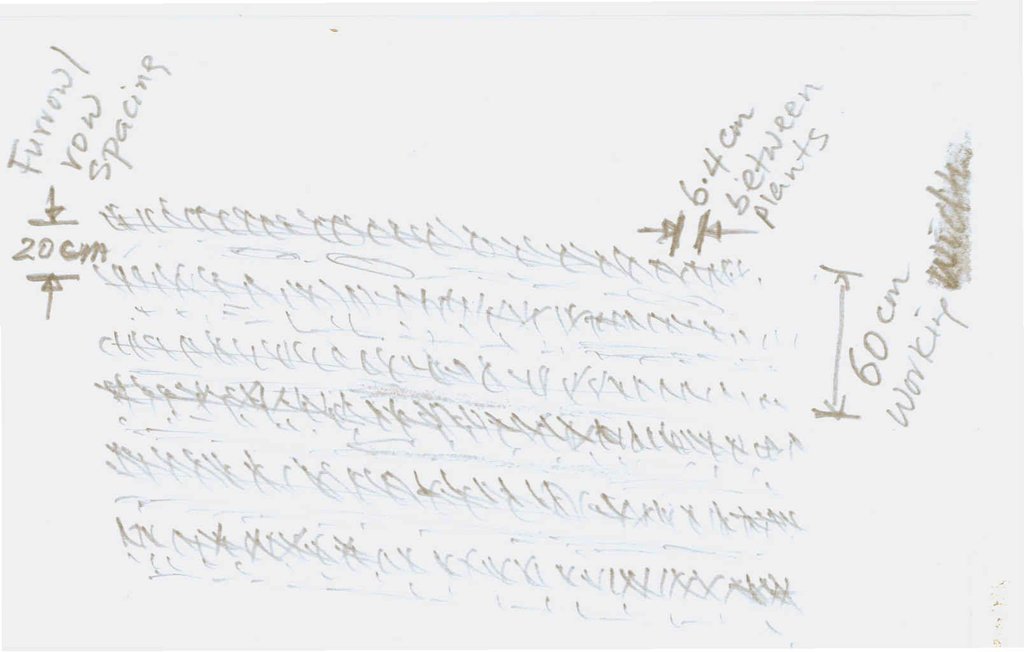Teff row planting [Эфиопия]
- Создание:
- Обновить:
- Составитель: Gizaw Desta Gessesse
- Редактор: –
- Рецензент: Alexandra Gavilano
Teff bemesmr mezrat (Amharic)
technologies_1192 - Эфиопия
Просмотреть разделы
Развернуть все Свернуть все1. Общая информация
1.2 Контактные данные специалистов и организаций, участвующих в описании и оценке Технологии
Специалист по УЗП:
Tefferra Abu
Bahir Dar Agricultural Mechanization and Food Science Research Centre
Эфиопия
Название организации (-ий), содействовавших документированию/оценке Технологии (если применимо)
Water and Land Resource Centre (WLRC) - Эфиопия1.3 Условия, регламентирующие использование данных, собранных ВОКАТ
Составитель и ответственный(-ые) специалист(-ы) согласны с условиями, регламентирующими использование собранных ВОКАТ данных:
Да
2. Описание Технологии УЗП
2.1 Краткое описание Технологии
Определение Технологии:
Teff row planting is an agronomic practice used to place Teff seeds (very small size) in rows of about 20cm apart and at predetermined depth with sufficient cover of firm soil.
2.2 Подробное описание Технологии
Описание:
Teff is a staple crop in Ethiopia and used to make 'Injera'. Teff is commonly planted in broadcast technique with a seed rate of 25-30 kg per hectare. This practice results in high competition for nutrient and water, lodging and low productivity (on average 1 ton/ha). Teff row planting is a newly adopted planting method applied for small size seeds of Teff grain. The row planting technique reduces the seed rate from 25kg/ha to 5-8 kg per hectare, ease the weed management, reduce lodging problem, and lessen plant density and then competition for sunlight, nutrient and water. It is practiced on Teff growing soils except on heavy clay soils or Vertisols where it is difficult to prepare defined rows due to the extreme swelling nature of the soil under near saturation moisture condition. However, under optimum soil moisture (45-50%) it is possible to place seeds in row using manual seed drill in black soils with clay texture. The technique is not perfectly working on stony fields. Seed application is possible using locally available plastic bottles with needle size opening to drop seeds, and newly manufactured seed drill pulled by one person.
Purpose of the Technology: The main purpose to practice Teff row planting is to reduce plant density or population per unit area and thereby increase productivity. It also aim to reduce the lodging problem. Additional advantage of row planting for small grain crop, there is some extent of labor reduction for weeding to some extent.
Establishment / maintenance activities and inputs: Teff row planting technique applies on fine seed bed after 3-5 tillage frequency using local ard plough called maresha pulled by pair of oxen. Once the seed bed is finely prepared, first using local adopted application tools like plastic bottles or hand metering the farmer prepares seed rate of 5-8 kg per hectare mixed with proportional sand (approximately seed to sand ratio of 1:3) - it is difficult to manage uniform application and even distribution by applying the seed alone. He applies along the row and step on to cover the seed and compact it. Similarly, fertilizer is applied in the same way. Second option, after the preparation of fine seed bed, seed application is facilitated using drum type manual seed drill (of weight 21 kg) manufactured by Bahir Dar Agricultural Mechanization and Food Science Research Center (BAMFSRC) having 3 rows of 20cm apart, average depth and width of planting furrow equals to 3.6 cm and 6.4 cm and operating at field capacity of 0.06ha/hr. The drill can apply 3-6 kg/ha seed rate and pulled by one person. At tillering stage urea is top dressed. The technique requires 50-60 person days per hectare to apply seed and fertilizer using hand metering/bottles compared to 2-4 person days per hectare using drum type seed drill. Labor requirement for weeding is also reduced by using row planting than broadcast method.
Natural / human environment: Teff grows on wider environment of altitude range 1800-2600 m above sea level. It performs well with annual rainfall of 750-850 mm and temperature of 10-27 degree Celsius. In fact, there are varieties with short growing period adapted under low rainfall conditions. The row planting technique applies commonly on red clay soils having high water holding capacity. The technique potentially applies on slopes ranging from 0-10% with low stone cover.
Teff row planting using manual seed application or hand metering technique can easily be practiced by households having large family labor. Farm households who used the manual seed drill of drum type should have the capacity to afford the seed drill and able to buy fertilizer. Teff is produced for food and market. It has a good price for sale.
Although teff has high market price in country as well as an emerging export market potential, it is produced annually by subsistence farmers. The land holding is small to meet their family food demands. Their wealth condition ranges poor to average characterized with low agricultural advisory, market and water supply services and inadequate infrastructures. Energy supply is relied on biomass energy. Rural education and health services are improved. Rural unemployment and landless populations are at high rates. In general, the well being of the rural people is under poor condition.
2.3 Фотографии, иллюстрирующие Технологию
Комментарии к фотографиям:
The area covered with Teff row planting referred in this database only considers the area of the pre-scale up activities in the WLRC learning watersheds. The practice is steadily growing over years in teff growing areas of the country in general and Amhara region in particular.
2.5 Страна/ регион/ места, где применяется Технология, информация о которых собрана в данной Анкете
Страна:
Эфиопия
Административная единица (Район/Область):
Amhara
Более точная привязка места:
Bahir Dar Zuria, Mecha, Yilmana Densa, and Dembecha
Охарактеризуйте пространственное распространение Технологии :
- равномерно-однородное применение на определенной площади
Если точная область неизвестна, укажите приблизительную площадь:
- 0,1-1 км2
Пояснения:
Boundary points of the Technology area: 10.630850, 37.506877; 11.274962, 37.226641; 11.355705, 37.426134; 11.649907, 37.500604
2.6 Сколько лет применяется данная Технология
Если год начала применения Технологии достоверно неизвестен, дайте примерную оценку:
- менее 10 лет назад (недавняя)
2.7 Внедрение Технологии
Укажите, как именно Технология УЗП была внедрена:
- в качестве научного/ полевого эксперимента
Пояснения (тип проекта и т.д.):
Teff row planting technique was started in research stations 10 to20 years ago. The technique is extended to large number of farmers' field since 2011 through the scale up program of the Ministry of Agriculture. For instance, in 2013 the Amhara region planned to cover 20-30% of teff growing fields.
3. Классификация Технологии УЗП
3.2 Текущий(-ие) тип(-ы) землепользования на территории, где применяется Технология

Пахотные угодья и плантации
- Однолетние культуры
- teff
Число урожаев за год:
- 1
Поясните:
Longest growing period in days: 180Longest growing period from month to month: July to December

Пастбищные угодья
- Livestock is grazing on crop residues
Пояснения:
Major land use problems (compiler’s opinion): Major land use problems are soil erosion by water, soil nutrient depletion, gully erosion, steep slope cultivation, land fragmentation, and inappropriate runoff drainage practices like drainage ditches on cultivated fields.
Major land use problems (land users’ perception): Land users commonly specify soil erosion by water, shallow soil depth or soil depletion, low productivity of the soil, scarcity of water, and shortage of grazing land or pasture.
3.4 Водоснабжение
Обеспеченность водой участков, где реализуется Технология :
- сочетание богарных и орошаемых земель
3.6 Мероприятия УЗП, выполняемые в рамках Технологии

Агрономические мероприятия
- A1: Растительный/ почвенный покров
Пояснения:
Type of agronomic measures: mineral (inorganic) fertilizers
3.7 Основные проблемы деградации земель, на решение которых направлена Технология

ухудшение физических свойств почв
- Фу: уплотнение
- Фк: растрескивание и коркообразование
Пояснения:
Main causes of degradation: soil management (Teff fields are tilled 4-5 times and heavily trampled/compacted by livestock before sowing)
Secondary causes of degradation: Heavy / extreme rainfall (intensity/amounts) (Heavy rainfall cause high runoff and then erosion. It also create sealing effect on the soil surface)
3.8 Предотвращение и снижение деградации земель, или восстановление нарушенных земель
Укажите цель Технологии по отношению к деградации земель :
- предотвращение деградации земель
- снижение деградации земель
4. Технические характеристики, мероприятия по практической реализации, вложения и стоимость
4.1 Технический рисунок, иллюстрирующий Технологию
Спецификация (пояснения к техническому рисунку):
A sketch describing Teff row planting
Location: Aba Gerima, Debre Mewi, Debre Yacob, Gosh Learning. West Gojam/ Amhara Region
Technical knowledge required for field staff / advisors: high (Because of its small seed size, the method requires knowledge of the soil where it performs well and at what depth the seed is placed so that there is high germination and minimizing lodging problem)
Technical knowledge required for land users: high (The land user has to develop capacity and skills on the specific soil and slope conditions where row planting performs well, spacing of rows, depth of furrow and seed quantity per unit area.)
Main technical functions: improvement of surface structure (crusting, sealing), increase of biomass (quantity), Reduction of plant population and competition effect
Secondary technical functions: improvement of topsoil structure (compaction)
Agronomic measure: Row planting
Material/ species: Teff seeds
Quantity/ density: 3-6kg/ha
Remarks: Spacing between rows is 20cm
Mineral (inorganic) fertilizers
Material/ species: Urea and DAP
Quantity/ density: 100 kg/ha
Remarks: for each type of fertilizer
Автор:
Gizaw Desta, WLRC
Дата:
2014-8-15
4.2 Общая информация по необходимым вложениям и стоимости
другая/ национальная валюта (название):
ETH BIRR
Если это необходимо, укажите обменный курс от доллара США к местной валюте (например, 1 доллар США = 79,9 бразильского реала): 1 доллар США =:
20,0
Укажите среднюю дневную заработную плату наемных работников:
3.00
4.3 Мероприятия, необходимые для начала реализации
| Деятельность | Время (сессия) | |
|---|---|---|
| 1. | Drum type row teff seeder (with 3 rows) |
4.4 Вложения и затраты, необходимые для начала реализации
| Опишите затраты | Единица | Количество | Затраты на единицу | Общая стоимость на единицу | % затрат, оплаченных землепользователями | |
|---|---|---|---|---|---|---|
| Оборудование | machine use | pc | 1,0 | 71,0 | 71,0 | 100,0 |
| Общая стоимость запуска Технологии | 71,0 | |||||
| Общие затраты на создание Технологии в долларах США | 3,55 | |||||
4.5 Поддержание/ текущее обслуживание
| Деятельность | Сроки/ повторяемость проведения | |
|---|---|---|
| 1. | Tillage | Annually after onset of rain, 4-5 times |
| 2. | Seeding | After the soil gets sufficient moisture annually |
| 3. | Weeding | 2-3 times per season |
| 4. | Harvesting | Annually at maturity period (Nov-Dec) |
| 5. | Threshing | Annually during slack period (Dce-Jan) |
| 6. | Transporting and storing grain and straw | Annually during slack period |
4.6 Стоимость поддержания/ текущего обслуживания ( в год)
| Опишите затраты | Единица | Количество | Затраты на единицу | Общая стоимость на единицу | % затрат, оплаченных землепользователями | |
|---|---|---|---|---|---|---|
| Оплата труда | labour | 1,0 | 318,0 | 318,0 | 100,0 | |
| Оборудование | animal traction | 1,0 | 266,0 | 266,0 | 100,0 | |
| Посадочный материал | seeds | 1,0 | 4,5 | 4,5 | 100,0 | |
| Посадочный материал | fertilizer | 1,0 | 150,0 | 150,0 | 100,0 | |
| Общая стоимость поддержания Технологии | 738,5 | |||||
| Общие затраты на поддержание Технологии в долларах США | 36,92 | |||||
Пояснения:
Machinery/ tools: Seed drill, local plough, sickle, hoe
The costs are calculated on hectare basis covered by row planting method. The costs apply for February/March 2014
4.7 Наиболее значимые факторы, влияющие на стоимость затрат
Опишите наиболее значимые факторы, влияющие на стоимость затрат:
The implementation costs are subject to change due to fluctuation in seasonal labor demand, price of fertilizer, price of iron to construct seed drill, and inflation
5. Природные и социально-экономические условия
5.1 Климат
Среднегодовое количество осадков
- < 250 мм
- 251-500 мм
- 501-750 мм
- 751-1000 мм
- 1001-1500 мм
- 1501-2000 мм
- 2001-3000 мм
- 3001-4000 мм
- > 4000 мм
Агроклиматическая зона
- Умеренно-влажная
- полузасушливая
Thermal climate class: subtropics
5.2 Рельеф
Склоны (преобладающие):
- пологие (0-2%)
- покатые (3-5%)
- покато-крутые (6-10%)
- крутые (11-15%)
- очень крутые (16-30%)
- чрезвычайно крутые (31-60%)
- обрывистые (>60%)
Формы рельефа:
- плато/ равнины
- гребни хребтов/холмов
- склоны гор
- склоны холмов
- подножья
- днища долин
Зона высотной поясности:
- 0-100 м над уровнем моря
- 101-500 м н.у.м.
- 501-1000 м н.у.м.
- 1001-1500 м н.у.м.
- 1501-2000 м н.у.м.
- 2001-2500 м н.у.м.
- 2501-3000 м н.у.м.
- 3001-4000 м н.у.м.
- > 4 тыс. м н.у.м.
5.3 Почвы
Средняя мощность почв:
- поверхностные (0-20 см)
- неглубокие (21-50 см)
- умеренно глубокие (51-80 см)
- глубокие (81-120 см)
- очень глубокие (> 120 см)
Гранулометрический состав (верхнего горизонта):
- средние фракции (суглинистый, супесчаный)
- тонкодисперсный/ тяжёлый (глинистый)
Содержание органического вещества в верхнем горизонте:
- высокое (> 3%)
- среднее (1-3%)
5.4 Доступность и качество воды
Уровень грунтовых вод:
> 50 м
Доступность поверхностных вод:
хорошая
Качество воды (без обработки):
исключительно для сельскохозяйственного использования (орошение)
5.5 Биоразнообразие
Видовое разнообразие:
- низкое
5.6 Характеристика землепользователей, применяющих Технологию
Рыночная ориентация производства:
- натуральное хозяйство (самообеспечение)
- смешанный (натуральный / коммерческий)
Доходы из других источников:
- < 10% всех доходов
Относительный уровень достатка:
- плохой
- средний
Индивидуальное или коллективное хозяйство:
- частное/ домовладение
Уровень механизации:
- ручной труд
- тягловая сила
Пол:
- женщины
- мужчины
Укажите другие важные характеристики землепользователей:
Difference in the involvement of women and men: Women play a role of applying seeds either using locally made plastic bottles or using the manual drum type seed drill to pull. However, men are involved in both in tillage and seeding practices.
Population density: 100-200 persons/km2
Annual population growth: 2% - 3%
5.7 Средняя площадь земель, используемых землепользователями с применением Технологии
- < 0,5 га
- 0,5-1 га
- 1-2 га
- 2-5 га
- 5-15 га
- 15-50 га
- 50-100 га
- 100-500 га
- 500-1000 га
- 1000-10000 га
- > 10000 га
Считается ли это мелким, средним или крупным хозяйством (по местным масштабам)?
- мелкое
Пояснения:
Average area of land owned or leased by land users applying the Technology: < 0.5 ha, 0.5-1 ha, 1-2 ha
5.8 Собственность на землю, права на земле- и водопользование
Землевладелец:
- государственная
- индивидуальная, оформленная в собственность
Право водопользования:
- неограниченное (неконтролируемое)
5.9 Доступ к базовым услугам и инфраструктуре
медицинское обслуживание:
- плохой
- средний
- хорошая
образование:
- плохой
- средний
- хорошая
технические консультации:
- плохой
- средний
- хорошая
занятость (вне хозяйства):
- плохой
- средний
- хорошая
рынки:
- плохой
- средний
- хорошая
электроснабжение:
- плохой
- средний
- хорошая
транспорт и дорожная сеть:
- плохой
- средний
- хорошая
водоснабжение и канализация:
- плохой
- средний
- хорошая
финансовые услуги:
- плохой
- средний
- хорошая
6. Воздействия и заключительные положения
6.1 Влияние Технологии УЗП в пределах территории ее применения
Социально-экономическое воздействие
Продуктивность
производство сельскозяйственных культур
Количество до применения УЗП :
1.2 ton/ha
Количество после применения УЗП:
>2.7 ton/ha
производство кормов
Количество до применения УЗП :
2.4 ton/ha
Количество после применения УЗП:
5 ton/ha
качество кормов
производство продуктов животноводства
Доходы и затраты
доходы хозяйства
Социальное и культурное воздействие
продовольственная безопасность/ самообеспечение
Improved teff agronomic knowledge
Экологическое воздействие
Водный цикл/ поверхностный сток
поверхностный сток
Почвы
влажность почв
образование корки на поверхности почв/ запечатывание
уплотнение почв
Биоразнообразие: растительность, животный мир
борьба с вредителями/ болезнями
6.3 Подверженность и чувствительность Технологии УЗП к постепенным изменениям климата и экстремальным погодным явлениям/ стихийным бедствиям, связанным с изменением климата (в понимании землепользователей)
Экстремальные явления, связанные с изменением климата (стихийные бедствия)
Погодные стихийные бедствия
| Насколько успешно Технология справляется с этим? | |
|---|---|
| местные ливневые дожди | плохо |
Стихийные бедствия климатического характера
| Насколько успешно Технология справляется с этим? | |
|---|---|
| засухи | плохо |
Другие воздействия, связанные с изменением климата
Другие воздействия, связанные с изменением климата
| Насколько успешно Технология справляется с этим? | |
|---|---|
| сокращение вегетационного периода | плохо |
6.4 Анализ эффективности затрат
Насколько получаемый результат сопоставим с первоначальными вложениями (с точки зрения землепользователей)?
Эффективность затрат в краткосрочной перспективе:
позитивное
Эффективность затрат в долгосрочной перспективе:
очень позитивное
Насколько получаемый результат сопоставим с текущими расходами по поддержанию технологии (с точки зрения землепользователей)?
Эффективность затрат в краткосрочной перспективе:
слабо позитивное
Эффективность затрат в долгосрочной перспективе:
позитивное
Пояснения:
Since the new technology (Teff row planting) requires high human labor while placing seeds using hand metering or plastic bottles (locally adopted) to apply the seeds, the land users perceived that the cost of labor is high and can not be affordable using family labor alone. Until they developed experience the return may be considered as slightly positive. However, if the land users adopt to use the manual drum type seed drill the return is very positive and positive as compared to the establishment and recurrent costs, respectively.
6.5 Внедрение Технологии
Пояснения:
There is a moderate trend towards spontaneous adoption of the Technology
Comments on adoption trend: The adoption is growing with extensive technical guidance and push from the research and extension services.
6.7 Сильные стороны/ преимущества/ возможности Технологии
| Сильные стороны/ преимущества/ возможности по мнению землепользователей |
|---|
|
There is yield advantage both grain and straw How can they be sustained / enhanced? The technique needs an improved tool to reduce labor demand. It has to be supported with improved varieties and agronomic practices |
| It requires small amount of seed |
| According to some farmers it avoids the usual practice called trampling of seed bed by livestock after sowing the seed |
| Сильные стороны/ преимущества/ возможности по мнению составителя или других ключевых специалистов |
|---|
|
Teff row planting can bring 30-50% yield advantage compared to the broadcasting method of planting How can they be sustained / enhanced? The yield advantage can be sustained by using an integrated or package of Teff production technologies such as improved teff varieties, recommended fertilizer, pesticides and weeding |
|
It reduces three to four times the amount of seed required using the broadcasting method How can they be sustained / enhanced? This advantage can be enhanced or continue to sustain by using an improved low cost seed drills |
|
The technology eases the weeding practice without damaging the plants How can they be sustained / enhanced? Appropriate low cost weeders or herbicides can be used to further enhance the technique |
|
The technology reduces damage due to lodging problem along with the use of selected Teff varieties having strong stem How can they be sustained / enhanced? This can be sustained if supported with further research in the depth of seed placement and genetic improvement |
6.8 Слабые стороны/ недостатки/ риски Технологии и пути их преодоления
| Слабые стороны/ недостатки/ риски по мнению землепользователей | Возможные пути их преодоления/снижения? |
|---|---|
| The implement has relatively low stability to make straight rows. | Improving the workmanship will solve the problem |
| Non uniform seed application if pulling speed not constant | Proper seed bed preparation and removal of stones will solve the problem |
| Слабые стороны/ недостатки/ риски по мнению составителя или ответственных специалистов | Возможные пути их преодоления/снижения? |
|---|---|
| Uniform application and distribution of small amount of seed (as low as 5kg) in rows of 20cm apart become challenging compared to the broadcasting technique | This can be overcome by continuous skill development through practice and training |
| The small number of plant populations or vigorous growth of teff plants favor the shoot fly damage. | Application of chemicals will control shootfly |
7. Справочные материалы и ссылки
7.1 Методы сбора/ источники информации
7.2 Ссылки на опубликованные материалы
Название, автор, год публикации, ISBN:
(Unpublished Report, 2013): Technical Evaluation and Selection of Suitable Teff Seed Drill in Amhara Region, by team of Researchers in ARARI, Bahir Dar Mechanization and Food Science research Center and Lecturers from Bahir Dar University
Название, автор, год публикации, ISBN:
Dereje Gorfu and Eshetu Ahmed (unpublished). Crops and Agro-ecological Zones of Ethiopia. Ethiopian Institute of Agricultural Research
Название, автор, год публикации, ISBN:
http://www.worldbank.org/html/cgiar/newsletter/Sept97/10tef.html
Ссылки и модули
Развернуть все Свернуть всеСсылки
Нет ссылок
Модули
Нет модулей





